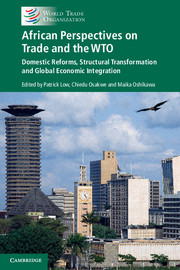 African Perspectives on Trade and the WTO
African Perspectives on Trade and the WTO Book contents
- African Perspectives on Trade and the WTO
- African Perspectives on Trade and the WTO
- Copyright page
- Contents
- Figures
- Plates
- Contributors
- Message
- Joint Foreword
- Book part
- Glossary
- Disclaimer
- 1 Introduction and Overview
- Part I The Future of the Multilateral Trading System: Perspectives from African Policy-Makers and Partners
- Part II Africa’s Participation in the Rules-Based Multilateral Trading System
- 10 Rising Africa in World Trade? A Story of Traditional Commodities and New Products
- 11 Trade Policy Trends in Africa: Empirical Evidence from Twenty Years of WTO Trade Policy Reviews
- 12 Preferential Trade Agreements in Africa: Lessons from the Tripartite Free Trade Agreements and an African Continent-Wide FTA
- 13 African Trade Integration and International Production Networks
- 14 Implementing Trade Facilitation Reform in Africa
- Part III Selected Development Experiences and Perspectives
- Book part
- Index
- Plate Section (PDF Only)
- Book part
- References
11 - Trade Policy Trends in Africa: Empirical Evidence from Twenty Years of WTO Trade Policy Reviews
from Part II - Africa’s Participation in the Rules-Based Multilateral Trading System
Published online by Cambridge University Press: 27 October 2016
- African Perspectives on Trade and the WTO
- African Perspectives on Trade and the WTO
- Copyright page
- Contents
- Figures
- Plates
- Contributors
- Message
- Joint Foreword
- Book part
- Glossary
- Disclaimer
- 1 Introduction and Overview
- Part I The Future of the Multilateral Trading System: Perspectives from African Policy-Makers and Partners
- Part II Africa’s Participation in the Rules-Based Multilateral Trading System
- 10 Rising Africa in World Trade? A Story of Traditional Commodities and New Products
- 11 Trade Policy Trends in Africa: Empirical Evidence from Twenty Years of WTO Trade Policy Reviews
- 12 Preferential Trade Agreements in Africa: Lessons from the Tripartite Free Trade Agreements and an African Continent-Wide FTA
- 13 African Trade Integration and International Production Networks
- 14 Implementing Trade Facilitation Reform in Africa
- Part III Selected Development Experiences and Perspectives
- Book part
- Index
- Plate Section (PDF Only)
- Book part
- References
Summary
Trade liberalization has been a key component of economic development and transformation in the global economy since the middle of the last century and is a leading force in fostering globalization and connectivity in the twenty-first century. Trade reform has been on the agenda of African economies, first under the IMF-supported structural adjustment programmes of the 1980s and the early 1990s, and subsequently pursued within the multilateral legal and policy framework of the WTO. Following two decades of rapid trade growth in Africa, the evidence suggests that significant barriers to trade remain within Africa, impeding its integration to regional and global value chains. Considerable scope exists for the use of trade policy to accelerate and deepen sustained economic development and transformation. African economies should embark on the next generation of trade and associated structural reforms more aggressively and ambitiously.
This chapter examines the evolution of trade policy reforms in Africa across the twenty-year period from 1995 to 2015. It addresses the three following questions: What have been the broad patterns and the substantive factors in African trade policy in the twenty-year period from 1995 to 2015? What factors have influenced African trade policy-making and implementation? What factors enhance our understanding of the evolution of African trade policy in this period? In answering these questions, the authors analyse 107 WTO Trade Policy Reviews (TPRs) conducted for forty-two African members. The results of the analysis show that, overall, Africa continued trade liberalization under the WTO, building on its earlier trade reforms, although the pace of reforms varied in different countries and different parts of the continent. Analysis focused, inter alia, on the use of selected trade policy instruments by African members, principally tariffs, ‘other’ border duties and taxes, non-tariff measures, such as import restrictions, measures related to customs procedures, state trading, export measures and trade in services. Drawing on quantitative and qualitative information extracted from the TPR reports and other WTO data, specific attention is accorded to policy developments at the regional level, which has accounted, in part, amongst the drivers for trade liberalization in Africa, although the pace and degree of such liberalization varied greatly among the sub-regions and from one country to another, including some cases of policy reversal and back-sliding registered in the use of particular trade policy instruments.
Key findings suggest that most African members used the WTO system below potential to support their trade and wider structural reforms and leverage for governance. It is argued that the influence of the origin of their inherited, rather than negotiated, GATT/WTO membership, a disproportionate focus on the Doha Development Agenda negotiations and inadequate technical capacity explain, in part, Africa‘s under-utilization of the multilateral framework for trade-driven development growth. It is suggested that African policy-makers, in future participation in the organization, would benefit from the following: strengthened bindings and commitments in the goods and services schedules; embarking on the next generation of structural reforms of which the WTO accession template remains relevant, addressing implementation gaps; maintaining a proactive utilization of regular WTO bodies for implementation of trade rules and the TPR oversight peer review mechanism; and, finally, a robust engagement for plurilateral initiatives in the wake of the WTO’s Tenth Ministerial Conference in Nairobi in 2015.
- Type
- Chapter
- Information
- African Perspectives on Trade and the WTODomestic Reforms, Structural Transformation and Global Economic Integration, pp. 105 - 229Publisher: Cambridge University PressPrint publication year: 2016
References
- 2
- Cited by


